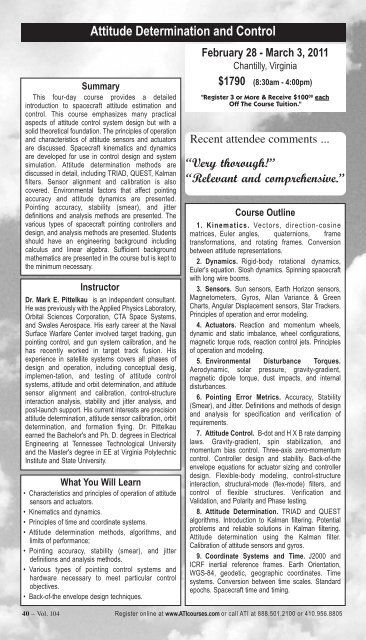Systems Engineering - ATI
Systems Engineering - ATI
Systems Engineering - ATI
You also want an ePaper? Increase the reach of your titles
YUMPU automatically turns print PDFs into web optimized ePapers that Google loves.
Attitude Determination and Control<br />
Summary<br />
This four-day course provides a detailed<br />
introduction to spacecraft attitude estimation and<br />
control. This course emphasizes many practical<br />
aspects of attitude control system design but with a<br />
solid theoretical foundation. The principles of operation<br />
and characteristics of attitude sensors and actuators<br />
are discussed. Spacecraft kinematics and dynamics<br />
are developed for use in control design and system<br />
simulation. Attitude determination methods are<br />
discussed in detail, including TRIAD, QUEST, Kalman<br />
filters. Sensor alignment and calibration is also<br />
covered. Environmental factors that affect pointing<br />
accuracy and attitude dynamics are presented.<br />
Pointing accuracy, stability (smear), and jitter<br />
definitions and analysis methods are presented. The<br />
various types of spacecraft pointing controllers and<br />
design, and analysis methods are presented. Students<br />
should have an engineering background including<br />
calculus and linear algebra. Sufficient background<br />
mathematics are presented in the course but is kept to<br />
the minimum necessary.<br />
Instructor<br />
Dr. Mark E. Pittelkau is an independent consultant.<br />
He was previously with the Applied Physics Laboratory,<br />
Orbital Sciences Corporation, CTA Space <strong>Systems</strong>,<br />
and Swales Aerospace. His early career at the Naval<br />
Surface Warfare Center involved target tracking, gun<br />
pointing control, and gun system calibration, and he<br />
has recently worked in target track fusion. His<br />
experience in satellite systems covers all phases of<br />
design and operation, including conceptual desig,<br />
implemen-tation, and testing of attitude control<br />
systems, attitude and orbit determination, and attitude<br />
sensor alignment and calibration, control-structure<br />
interaction analysis, stability and jitter analysis, and<br />
post-launch support. His current interests are precision<br />
attitude determination, attitude sensor calibration, orbit<br />
determination, and formation flying. Dr. Pittelkau<br />
earned the Bachelor's and Ph. D. degrees in Electrical<br />
<strong>Engineering</strong> at Tennessee Technological University<br />
and the Master's degree in EE at Virginia Polytechnic<br />
Institute and State University.<br />
What You Will Learn<br />
• Characteristics and principles of operation of attitude<br />
sensors and actuators.<br />
• Kinematics and dynamics.<br />
• Principles of time and coordinate systems.<br />
• Attitude determination methods, algorithms, and<br />
limits of performance;<br />
• Pointing accuracy, stability (smear), and jitter<br />
definitions and analysis methods.<br />
• Various types of pointing control systems and<br />
hardware necessary to meet particular control<br />
objectives.<br />
• Back-of-the envelope design techniques.<br />
February 28 - March 3, 2011<br />
Chantilly, Virginia<br />
$1790 (8:30am - 4:00pm)<br />
"Register 3 or More & Receive $100 00 each<br />
Off The Course Tuition."<br />
Recent attendee comments ...<br />
“Very thorough!”<br />
“Relevant and comprehensive.”<br />
Course Outline<br />
1. Kinematics. Vectors, direction-cosine<br />
matrices, Euler angles, quaternions, frame<br />
transformations, and rotating frames. Conversion<br />
between attitude representations.<br />
2. Dynamics. Rigid-body rotational dynamics,<br />
Euler's equation. Slosh dynamics. Spinning spacecraft<br />
with long wire booms.<br />
3. Sensors. Sun sensors, Earth Horizon sensors,<br />
Magnetometers, Gyros, Allan Variance & Green<br />
Charts, Angular Displacement sensors, Star Trackers.<br />
Principles of operation and error modeling.<br />
4. Actuators. Reaction and momentum wheels,<br />
dynamic and static imbalance, wheel configurations,<br />
magnetic torque rods, reaction control jets. Principles<br />
of operation and modeling.<br />
5. Environmental Disturbance Torques.<br />
Aerodynamic, solar pressure, gravity-gradient,<br />
magnetic dipole torque, dust impacts, and internal<br />
disturbances.<br />
6. Pointing Error Metrics. Accuracy, Stability<br />
(Smear), and Jitter. Definitions and methods of design<br />
and analysis for specification and verification of<br />
requirements.<br />
7. Attitude Control. B-dot and H X B rate damping<br />
laws. Gravity-gradient, spin stabilization, and<br />
momentum bias control. Three-axis zero-momentum<br />
control. Controller design and stability. Back-of-the<br />
envelope equations for actuator sizing and controller<br />
design. Flexible-body modeling, control-structure<br />
interaction, structural-mode (flex-mode) filters, and<br />
control of flexible structures. Verification and<br />
Validation, and Polarity and Phase testing.<br />
8. Attitude Determination. TRIAD and QUEST<br />
algorithms. Introduction to Kalman filtering. Potential<br />
problems and reliable solutions in Kalman filtering.<br />
Attitude determination using the Kalman filter.<br />
Calibration of attitude sensors and gyros.<br />
9. Coordinate <strong>Systems</strong> and Time. J2000 and<br />
ICRF inertial reference frames. Earth Orientation,<br />
WGS-84, geodetic, geographic coordinates. Time<br />
systems. Conversion between time scales. Standard<br />
epochs. Spacecraft time and timing.<br />
40 – Vol. 104 Register online at www.<strong>ATI</strong>courses.com or call <strong>ATI</strong> at 888.501.2100 or 410.956.8805

















